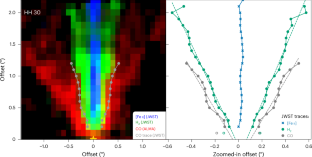2024-10-04 マックス・プランク研究所
<関連情報>
- https://www.mpg.de/23449608/jameswebb-winds-planet-forming-disk
- https://www.nature.com/articles/s41550-024-02385-7
JWST/NIRSpecの観測から明らかになった若い星の円盤風の入れ子形態 The nested morphology of disk winds from young stars revealed by JWST/NIRSpec observations
Ilaria Pascucci,Tracy L. Beck,Sylvie Cabrit,Naman S. Bajaj,Suzan Edwards,Fabien Louvet,Joan R. Najita,Bennett N. Skinner,Uma Gorti,Colette Salyk,Sean D. Brittain,Sebastiaan Krijt,James Muzerolle Page,Maxime Ruaud,Kamber Schwarz,Dmitry Semenov,Gaspard Duchêne & Marion Villenave
Nature Astronomy Published:04 October 2024
DOI:https://doi.org/10.1038/s41550-024-02385-7

Abstract
Radially extended disk winds could be the key to unlocking how protoplanetary disks accrete and how planets form and migrate. A distinctive characteristic is their nested morphology of velocity and chemistry. Here we report James Webb Space Telescope near-infrared spectrograph spectro-imaging of four young stars with edge-on disks, three of which have already dispersed their natal envelopes. For each source, a fast collimated jet traced by [Fe ii] is nested inside a hollow cavity within wider lower-velocity H2. In one case, a hollow structure is also seen in CO ro-vibrational (v = 1 → 0) emission but with a wider opening angle than the H2, and both of those are nested inside an Atacama Large Millimeter Array CO (J = 2 → 1) cone with an even wider opening angle. This nested morphology, even for sources with no envelope, strongly supports theoretical predictions for wind-driven accretion and underscores the need for theoretical work to assess the role of winds in the formation and evolution of planetary systems.




